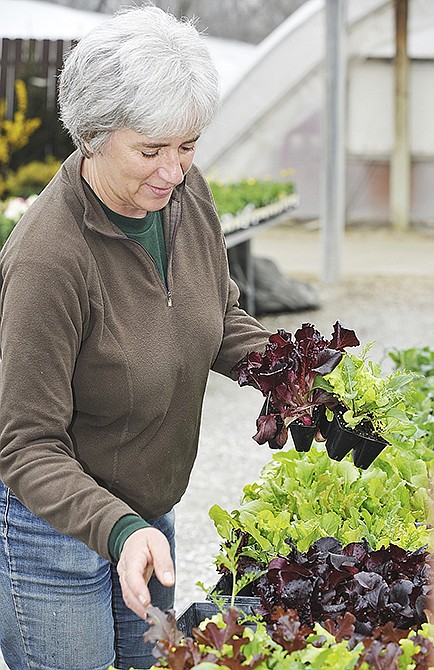In early spring, many Missouri gardeners begin preparing cool-season crops, such as cabbages, cauliflower, broccoli and head lettuces. Gardeners start these crops in containers or greenhouses and transplant them in their gardens when the weather warms.
Gail Cummins, a member of Central Missouri Master Gardeners, starts growing her vegetables in containers as early as late February. Besides giving the plants a quick start, container gardening can save money and lead to better yields.
Among greens and lettuces, Alice Longfellow, of Longfellow's Garden Center in Centertown, says black-seeded Simpsons, leafy bright green lettuces, are really popular. The center has many cool-season crops in plant form that cannot be planted from seed. In her outside garden, Longfellow pointed to the red sails and Swiss chards ready for transplanting. Other crops include mesclun mix lettuces - both plain and spicy - red sails lettuces, mustard greens and arugula.
Cool-season crops that can be planted directly from seed include spinach, radishes, turnips and peas. Yet, in early March, the weather can sometimes be too cold to grow potatoes.
"Some people think that you are supposed to plant on St. Patrick's Day, but most years that's too early, the ground is still too cold. This year probably was OK, because we had such a warm week before that," Longfellow said.
She said potatoes can be planted as late as mid-April, but if they are planted too early, the cold, damp soil can cause them to rot.
Spring is also a good time to start a garden from scratch. For people who would like to grow their own veggies, there are a few preliminary steps to follow. The first thing to consider is the site or the location to grow the plants. The site must have at least eight hours of sunlight, good access to a water supply and be in an area clear of trees or a good distance away from them.
The next thing to keep in mind is soil condition. In order to decide what kind of nutrients their soil needs, gardeners can have soil tested through the University of Missouri Extension program, which will provide them with information about the soil's nutrients level. Since much of Missouri soil contains clay, compost fertilizer may be used to help break up the clay to allow in water and nutrients.
Most importantly, one must keep track of the soil temperature before planting.
"Peas you can plant when the soil temperature is 45 degrees, which is very cool. Most plants that you want to put in the ground - cabbage, cauliflower and broccoli - we recommend 60 degrees soil temperature because that's when good root growth and good, fast top growth occurs," said Bob Trinklein of Trinklein Brothers Greenhouses in Jefferson City.
To keep track of soil temperature, Trinklein uses a soil thermometer. He noted, though, that using an ordinary cooking thermometer can work as well.
When it comes to deciding what to plant, it is best to start gradually and plant more as you gain experience. Many varieties of vegetables can be planted during spring, and the best way to go about it is simply to grow only what is needed.
"When you look at what you plant, look at what your family consumes," said Jeanne Schwaller, former horticultural professor of the University of Missouri Extension program and master gardener.
Schwaller said what people eat may vary by region, but not always. Although her family is from the south, where collard greens are prevalently grown, she doesn't like to eat them.
Checking your garden daily helps with pest and disease control. How you maintain a garden can vary depending on whether you decided to plant organically. Organic gardeners do not use any manufactured chemicals on their plants - though, in some cases, gardeners who are not completely organic may use a combination of organic and nonorganic pesticides and fertilizers depending on the severity of the problem. If the problem seems minor, a gardener can resort to mechanical means.
"If I got a tomato hornworm, I'll look until I find it and I will pull him off and cut him in half and he's done. If I've got squash bugs, I will spend the time first, especially when they're real young, to get them and try to smash them," Cummins said.
Household remedies also may keep certain pests at bay.
"A very popular solution is 2 tablespoons of baking soda in a gallon of water as a great way to control a lot of leaf diseases," Longfellow said. "You can apply a tablespoon of ivory liquid soap in a gallon of water, and it controls aphids and many other insects."
Essentially, gardening one's own vegetables is a beneficial and pleasurable experience. It ensures freshness and intensifies flavor in seasonal dishes and gives gardeners more control over the types of products used to grow their gardens. Gardeners also find enjoyment in just watching their plants grow and observing the interworking of nature.
"I think that growing vegetables just gives us a sense of, well satisfaction," Cummins said. "Spring after spring, I still have that same thrill to know that the earth and the rain and the sunshine can all help open that seed up and make a plant, but then also something that I can eat."
Correction: Former University of Missouri Extension horticultural professor Jeanne Schwaller's name was misspelled in the original version of this article when it was published March 29. The error has since been fixed in the text above.

